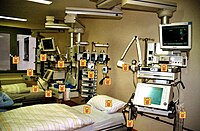
Photo from wikipedia
BACKGROUND Non-ventilator associated hospital acquired pneumonia (NV-HAP) affects approximately 1 in 100 hospitalized patients yet risk-adjusted outcomes associated with developing NV-HAP are unknown. METHODS Retrospective cohort study with propensity score… Click to show full abstract
BACKGROUND Non-ventilator associated hospital acquired pneumonia (NV-HAP) affects approximately 1 in 100 hospitalized patients yet risk-adjusted outcomes associated with developing NV-HAP are unknown. METHODS Retrospective cohort study with propensity score matched populations (NV-HAP versus no NV-HAP), using ICD-10 codes for bacterial pneumonia not present on admission. Outcomes included the patient level probability of NV-HAP developing among acute care non-transfer admissions in 133 Veterans Affairs hospitals and subsequent mortality, length of stay, inpatient sepsis, and 12-month costs. RESULTS NV-HAP occurred in 0.6% of Veteran admissions. Among admissions that developed NV-HAP, the mean length of stay of 26.3 days (6.72 days among non-NV-HAP), 30-day mortality was 18.4% (4.5% among non-NV-HAP), 1-year mortality was 47.8% (21.4% among non-NV-HAP), and total median 12-month direct medical costs were $138,136.32 ($64,357.21 among non-NV-HAP). Inpatient sepsis occurred in approximately 20% of NV-HAP admissions (0.7% among non-NV-HAP). Data available at admission was insufficient to identify high and low risk patient groups. CONCLUSIONS NV-HAP is associated with severely worse patient outcomes and increased costs of care up to 12 months post-episode. Since population risk stratification is not feasible, prevention efforts should be directed at the full population of hospitalized Veterans.
Journal Title: American journal of infection control
Year Published: 2022
Link to full text (if available)
Share on Social Media: Sign Up to like & get
recommendations!